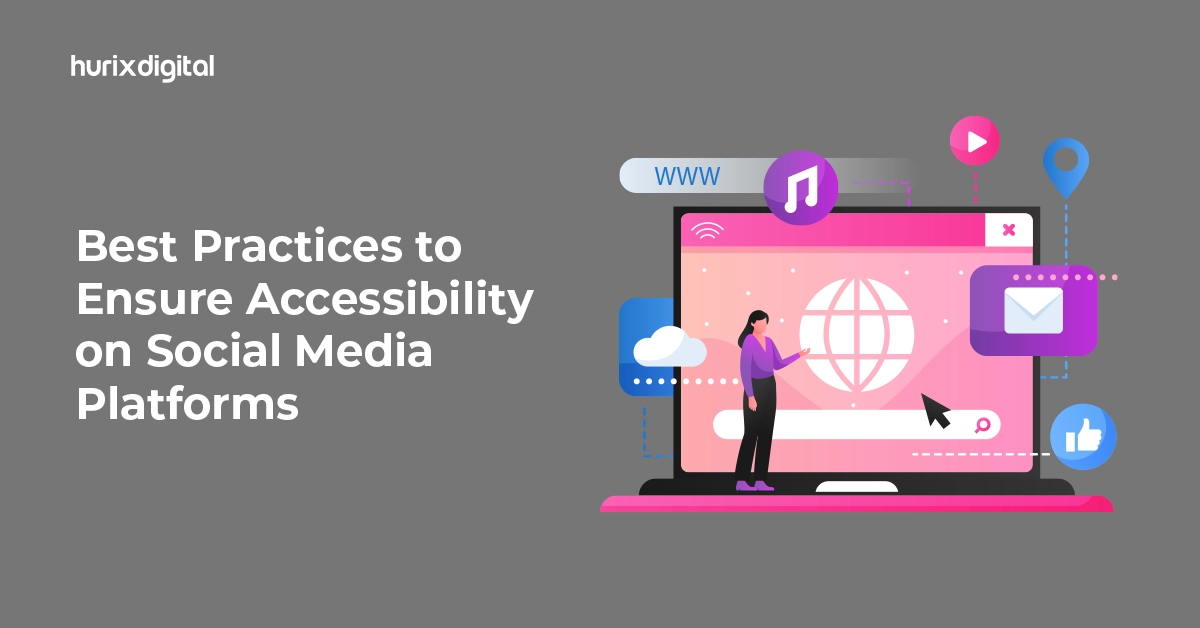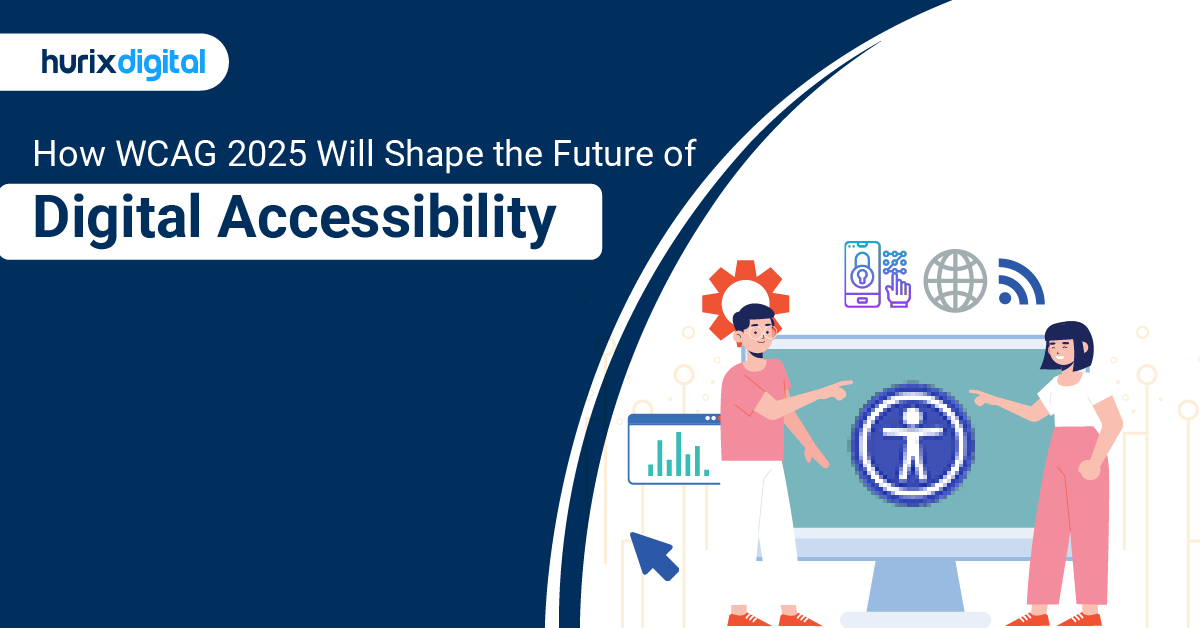
Best Practices to Ensure Accessibility on Social Media Platforms
Summarize with:
Social media platforms connect people and businesses worldwide. Key platforms like Facebook, Instagram, and TikTok are accessible to everyone. As of April 2024, 62.3% of the world’s population uses social media platforms, with an average daily usage of 2 hours and 23 minutes.
Today, 15% of the world’s population has some kind of disability, according to the World Health Organization. It is crucial to make these social media platforms accessible to this large segment of society. This is not only for following a trend but also to emphasize inclusion and empathy.
If your business or organization encourages web content with user-centered design and key accessibility features, it shows how much you value people with disabilities. Moreover, it is necessary to follow accessibility guidelines to stay effective in the digital arena today.
Learn more about online accessibility guidelines and assistive technologies that enhance social media accessibility!
Table of Contents:
- Why Social Media Accessibility Matters
- Best Practices to Encourage Inclusive Social Media Accessibility
- Final Posting Tips
- Tools and Resources for Accessibility
- Conclusion
Why Social Media Accessibility Matters
Social media accessibility ensures that all users can participate in digital interactions. It ensures that even the users with disabilities are engaged fully, and can gather critical information.
Further, they can contribute to discussions. Today, incorporating web accessibility features into digital content has become a legal norm in many jurisdictions.
Let us understand some core inclusive design principles first!
- Inclusive design in social media enhances user experience and is a critical subject for anyone creating digital content.
- It considers the diverse needs of all users, including those with disabilities.
- It incorporates various linguistic and cultural backgrounds.
- It includes using larger font sizes for better readability.
- It reduces text in images to avoid cognitive overload.
- It is critical to select the right font style, like choosing between serif and sans-serif, to improve legibility.
Also Read: The Importance of Accessibility Solutions in a Marketing Campaign
Best Practices to Encourage Inclusive Social Media Accessibility
Inclusive design can transform the social media experience and make it more engaging. This highlights the huge benefit of accessible content. Let us consider some best practices:
1. Introduce Alt Text
Adding alternative text to images is crucial. It allows readers to understand the visuals who cannot see them. Social media platforms offer specific fields for this purpose.
Effective alt text should directly tell the image’s content without filler phrases like “image of.” The best way to add alt text is to add humor and transcribe the given text in the image, which can enhance the alt text’s value.
2. Add Video Captions
Subtitles are essential for users who are deaf or hard of hearing and also helpful for people who prefer watching videos without sound. Social media platforms provide tools to add closed captions, which means you can toggle them on or off at your convenience.
3. Accessible Text and Hashtags
You must give importance to text clarity. Use plain language and avoid fancy fonts or text styles that can confuse screen readers. Hashtags should be written in Camel to improve readability. Emojis should be used and placed strategically to avoid disrupting the text flow.
4. SEO and Alt Text
While alt text primarily enhances accessibility, it can also improve content discoverability within social media platforms. However, the focus should always be on clarity and detail in descriptions rather than SEO.
The condition required is that Alt text should be used to describe images accurately and not for embedding hidden messages. Something like this can alienate users who rely on this feature.
5. Streamlining URL Presentation
It is advisable to simplify URLs. Twitter automatically shortens URLs, and other platforms may require a third-party service.
This feature condenses the link and retains essential elements like “dot com” to ensure clarity that it’s a URL. When incorporating URLs into your posts, introduce them clearly at the end to maintain the flow of information and ensure they are contextualized properly.
6. Designing Accessible Visual Content
Create visuals that everyone can enjoy by following these strategies:
- Ensure a minimum color contrast ratio of 4.5:1 for text against backgrounds, as recommended by the WCAG. Tools like the color contrast analyzer can help verify your user-centered design choices.
- Use symbols or text labels in addition to color to convey information. This will help those with color vision deficiencies.
- Avoid animations that flash excessively to prevent triggering neurological conditions.
- Large blocks of text should be placed in the post caption to allow users to adjust text size and color.
7. Guidelines for Memes and Emojis
Some memes and emojis can present accessibility challenges. Here are some tips:
- Provide comprehensive descriptions that convey both content and the context.
- Emojis should be placed at the end of sentences. To avoid distracting screen readers, limit their use to 3 per post.
8. Adopt Inclusive Language
Inclusive language ensures communications are accessible to all. You must:
- Refrain from using biased terms that can marginalize groups. Gender-neutral language should be used to avoid bias.
- Say “a person with a disability” rather than “a disabled person.”
- Stay informed about preferred terms and avoid offensive language.
9. Prioritize Diversity in Visual Content
To prioritize diversity in your visual web content, you must ensure that your visuals reflect diverse races, ages, and identities.
- Engage with content creators and digital partners who bring diverse perspectives.
- Feature diverse groups consistently, not just during specific months or events.
10. Effective Captioning Practices
Proper captioning is essential for web accessibility:
- On Instagram, utilize the Stories sticker for automatic transcription, which can be edited for accuracy.
- On TikTok, you can edit auto-generated captions directly in the app.
- On Facebook and LinkedIn, you can use pre-caption videos using services or apps before uploading.
11. Embracing Feedback and Routine Inclusion
Accessibility is a learning process. Accept feedback and integrate accessible practices into your regular content workflow. This enhances inclusivity and broadens your audience’s reach. It also helps your business emphasize ethical standards and business objectives.
Final Posting Tips
When finalizing social media posts:
- Use large, sans-serif fonts.
- Ensure high contrast between text and background.
- Always provide video captions.
- Offer clear directions for obtaining more information, like a link or an email address.
- Alt text should be brief—if it is too lengthy for a tweet, it may be too long for an alt text.
- Include any textual content shown in the image accurately.
- Mention significant elements like dates or identities where they add value to the image’s understanding.
Tools and Resources for Accessibility
Here are some important tools that can help you enhance social media accessibility:
- Web Content Accessibility Guidelines (WCAG) 2.1
- Readability and contrast tools for readability checks and for ensuring visual clarity.
- Automated solutions for adding captions and simulating color blindness. This ensures your content is accessible to a diverse audience.
Also Read: What is Gamification in Marketing? How to Use Gamification to Boost Your Marketing Campaigns?
Conclusion
Accessible content on social media is now a legal and ethical obligation. It is also a strategic advantage for your businesses. It increases your reach and engagement and enhances overall user experience and satisfaction.
Social media accessibility and digital inclusion effectively accommodate disabilities. It is all about creating content that is universally comprehensible and enjoyable.
Partner with champions at Hurix Digital to make the most of such foundational practices. Expert advice from professionals will make your social media platforms more inclusive and welcoming to all users, paving the way for a more connected and engaged audience.
Want to learn more? Contact us today!
Summarize with:

Vice President – Content Transformation at HurixDigital, based in Chennai. With nearly 20 years in digital content, he leads large-scale transformation and accessibility initiatives. A frequent presenter (e.g., London Book Fair 2025), Gokulnath drives AI-powered publishing solutions and inclusive content strategies for global clients
 Upcoming Masterclass | Build an Army of Brand Evangelists using Training & Development | November 20th, 8am PT | 9PM IST |
Upcoming Masterclass | Build an Army of Brand Evangelists using Training & Development | November 20th, 8am PT | 9PM IST |



